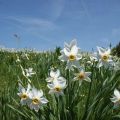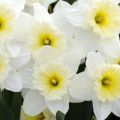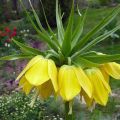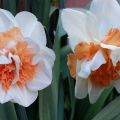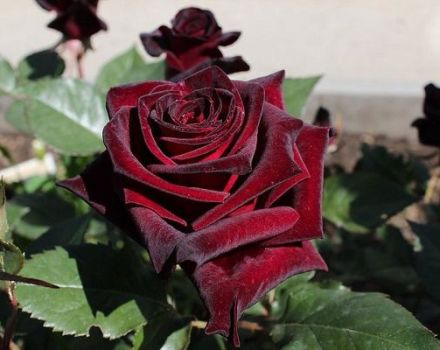Description and characteristics of the Obdam narcissus variety, planting and care rules
Terry narcissus Obdam is one of the representatives of bulbous perennials. Included in the group of terry daffodils. Created in the Netherlands and named after a city in the northern province. Obdam is recommended for growing outdoors in containers, in flower beds, in mixborders. Thanks to its good winter hardiness and unpretentiousness, this delicate and graceful variety has gained popularity among flower growers.
Description and characteristics of the Obdam variety
A double, peony flower of white color with a yellowish tinge in the center, up to 10 cm in diameter, has a delicate, delicate aroma. Peduncle leafless, up to 45 cm long. Leaves are narrow, basal. Terry Obdam blooms in April-May, flowering duration - 10 days.
The pros and cons of a narcissist
Narcissus Obdam does not have special requirements for soil fertility and care, adapts well to growing conditions, does not require an annual transplant. It tolerates shade easier than tulips. Under favorable conditions in the sun, it gives abundant flowering and a good yield of planting material. The variety does not tolerate excessive moisture. In the shade, the flower may not fully open.
Attention! Terry daffodils of the Obdam variety are not recommended to be grown among the grass.
The subtleties of growing a flower
The daffodil is transplanted after 4-5 years.
Timing
The acquired bulbs are transplanted and planted in the fall, in September, so that they can take root before the onset of frost. It is better to wait out the period of prolonged rains and choose dry weather for planting.
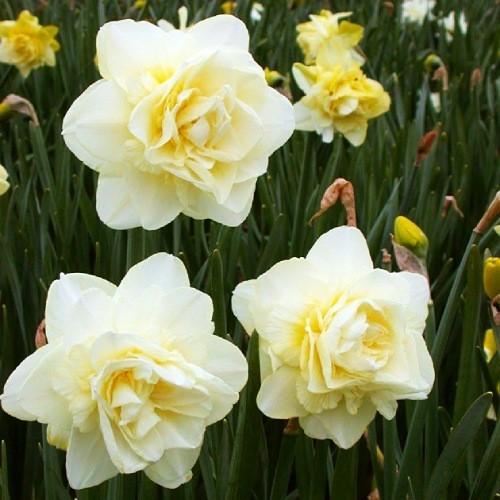
Although planting daffodils in spring is not the best time, it is practiced in some cases. The bulbs are kept in the refrigerator for at least two months to pass the rest period. After the snow melts, the bulbs are planted in the ground. The optimum temperature for spring rooting is no more than 7 ºC.
Site preparation
Daffodils of the Obdam variety adapt well to growing conditions, but they give high-quality flowering in well-lit areas with fertile, neutral soil. Acidic soils are neutralized by adding dolomite flour or wood ash. The soil should have a loose structure and good air exchange. On heavy soils, sand is added to loosen it. Compost or humus is added to improve nutritional value. Bulbs react negatively to manure use.
Before planting, the soil is dug up in advance so that it compresses, and the bulbs lay down to the desired depth.
Planting material
The bulbs are dug up, the withered leaves and dead scales are removed. Species with signs of the disease damaged by pests are rejected and destroyed. Healthy bulbs are washed and kept in a pink solution of potassium permanganate for disinfection. Then the children are separated, the planting material is dried in the shade and stored at a temperature not exceeding 16 ºC.

The optimum shelf life for daffodil bulbs before planting is no more than 2 months. With longer storage, they will lose some of the moisture and nutrients.
Attention! Live roots are not cut off from the bulbs.
Disembarkation process
The bulbs are planted in the prepared soil in ridges, groups and single plants. The bulb is buried to a depth equal to its threefold height. The distance between the plants depends on how long you plan to grow them without replanting. The optimal scheme for a 5-year-old culture is at least 15x15 cm. After planting, the soil is mulched with wood shavings, sawdust, and chopped straw.
Narcissus Care Tips
Daffodils require no more attention than other perennials.

Watering rules
Daffodils Obdam love moderately moist soil. From the moment of germination in dry weather, plants need watering. Watering is stopped 2 weeks after flowering.
How to fertilize correctly
For abundant flowering, daffodil Obdam is fed 3-4 times per season. Before flowering, a complex mineral fertilizer for flowers is applied per 1m2:
- first, after germination - 30 g;
- the second and third, during the budding period - 20 g.
After flowering, phosphorus-potassium fertilizer (2: 1) is used - 50 g per 1 m2. Fertilizer is applied when watering, after which the soil is shallowly loosened.
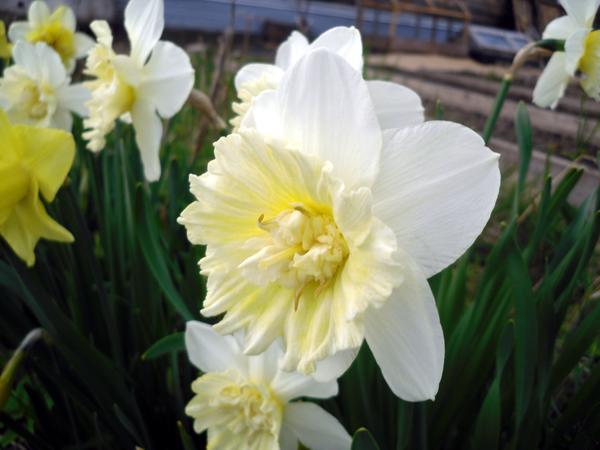
Pruning process
It is better to shoot flowers for bouquets in the morning, evening or afternoon in cloudy, dry weather. The stems break easily without a knife. Leaves are not completely cut to allow the plant to develop further.
Caution! Flowers cut in rainy weather quickly darken and deteriorate from moisture.
Diseases, pests and methods of dealing with them
Under unfavorable conditions, there is a risk of developing diseases. The most common are bacterial rot, fusarium, sclerotinosis, mosaic disease. To combat diseases, fungicidal preparations are used: copper sulfate (100 g per 10 l of water), Hom (40 g per 10 l) and others. Spraying is carried out after flowering, the solution consumption is 1-2 liters per 1 sq. m.
Among pests, the most dangerous are onion hoverflies, onion root mites and nematodes. For prevention, daffodils are sprayed with Fitoverm (2 ml per 10 l of water) before budding begins.

Breeding flowers
Terry narcissus Obdam is propagated by daughter bulbs (babies), which are laid in the axils of the bulb scales. Then the scales die off, the babies separate and become an independent plant. It takes a daffodil from two to four years to do this, depending on the growing conditions. It takes about two years from the bud of renewal to the beginning of flowering.
Attention! It does not make sense to propagate by seeds Obdam terry daffodil, since it will not retain varietal differences.
Narcissus Obdam in landscape design
Groups of Obdam flowers of various sizes will decorate any garden, park, square or adjacent territory. They look spectacular in flower beds with other early flowering plants. White color sets off bright tulips, hyacinths and primroses, green junipers, thuja, cypresses, green lawn. Daffodils are suitable for rock gardens, garden groups. They are planted near recreation areas, reservoirs, garden paths, rare deciduous shrubs and single trees.


